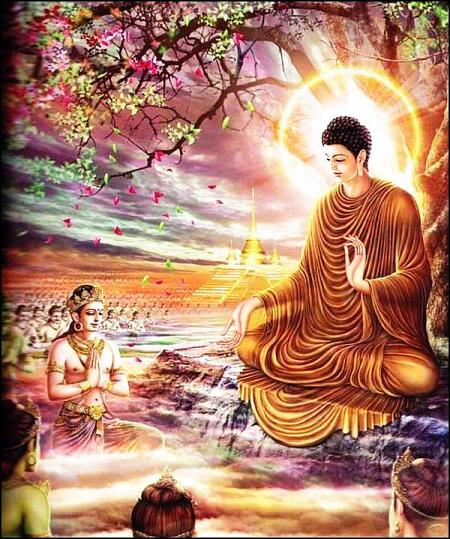The first centuries after Śākyamuni Buddha‘s death saw the rise of multiple schools of thought and teacher lineages within the Buddhist community as it spread throughout the Indian subcontinent. These new forms of scholarly monastic communities had distinct theoretical and practical interests and, in their efforts to organize, interpret, and reexamine the Buddha’s scattered teachings, they developed a particular system of thought and method of exposition called Abhidharma (Pali, Abhidhamma). The Sanskrit term abhidharma seems to derive from the expression “concerning (abhi) the teaching(s) (Skt., dharma, Pali, dhamma).” For the Buddhist exegetical tradition, however, the term means approximately “higher” or “further” teaching, and it refers both to the doctrinal investigations of the new scholastic movement and to the body of texts yielded by its systematic exposition of Buddhist thought. This body of literature includes the third of the “three baskets” (Skt., tripiṭaka, Pali, tipiṭaka) of the Buddhist canon, namely, the Abhidharma-piṭaka (Pali, Abhidhamma-piṭaka), its commentaries, and later exegetical texts.
Early Buddhism analyzed experience into 5 skandhas or aggregates, and alternatively into 18 dhatus or elements. Later schools developed the process of analysis and classification that was called Abhidharma; their treatises were collected in the Abhidharmapitaka, one of the three main divisions of the Pali Buddhist canon. The five skandhas analyzed experience to demonstrate the absence of an abiding “self.” The categories of analysis were dharmas, or natures, ultimate qualities or principles that arise and pass away in irreducible moments of time. The lists of dharmas varied from 75 to 157, with different schools classifying the dharmas into different groups, and the exact definition of a dharma eventually became the subject of great controversy. The greatest systematizer of Abhidharma thought was Vasubandhu (5th cent. AD), who wrote the encyclopedic Abhidharma-kosa or Treasury of Abhidharma.
Unlike the earlier Buddhist discourses that are colloquial in nature, the Abhidharma method presents the Buddha’s teachings in technical terms that are carefully defined to ensure analytical exactitude. In content, Abhidharma is distinctive in its efforts to provide the theoretical counterpart to the Buddhist practice of meditation and, more broadly, a systematic account of sentient experience. It does so by analyzing conscious experience—and in this sense one’s “world”—into its constituent mental and physical events (Skt., dharmā). The overarching inquiry subsuming both the analysis of dharmas into multiple categories and their synthesis into a unified structure by means of their manifold relationships of causal conditioning is referred to as the “dharma theory.” The exhaustive investigations into the nature and interaction of dharmas extended into the fields of metaphysics, epistemology, and ontology, and generated doctrinal controversies among different Buddhist schools. The Abhidharma analysis of and methods of argumentation about these controversies provided the framework of reference and defined the agenda for the Mahāyāna schools of Madhyamaka and Yogācāra. As a distinct doctrinal movement, then, Abhidharma had a remarkable impact on subsequent Buddhist thought and gave rise to Buddhist systematic philosophy and hermeneutics.
The Abhidhamma (Abhidharma in Sanskrit), also known as Shastra, is the most important and interesting, as it contains the profound philosophy of the Buddha’s teaching in contrast to the illuminating but simpler discourses in the Sutra Pitaka.
In the Sutra Pitaka one often finds references to individual, being, etc., but in the Abhidhamma, instead of such conventional terms, we meet with ultimate terms, such as aggregates, mind, matter etc. In the Abhidhamma everything is analyzed and explained in detail, and as such it is called analytical doctrine (Vibhajja Vada). Four ultimate things (Paramattha) are enumerated in the Abhidhamma. They are Citta (Consciousness), Cetasika (Mental concomitants). Rupa (Matter) and Nibbana. The so-called being is microscopically analyzed and its component parts are minutely described. Finally the ultimate goal and the method to achieve it is explained with all necessary details.
The Pali Abhidhamma Pitaka encompasses the following texts, or pakaranas:
(1) Dhammasangani (“Summary of Dharma”), a psychologically oriented manual of ethics for advanced monks. This book enumerates all the paramattha dhamma (ultimate realities) to be found in the world. According to one such enumeration these amount to: 52 cetasikas (mental factors), which, arising together in various combination, give rise to any one of 89 different possible cittas (states of consciousness) and 4 primary physical elements, 23 physical phenomena derived from them and Nibbana. Contains the description of the fundamental, ultimate mental, and physical phenomena constituting human experience.
(2) Vibhanga (“Division” or “Classification”—not to be confused with a Vinaya work or with several suttas bearing the same name), a kind of supplement to the Dhammasangani, treating many of the same topics. Contains the exposition of the analysis in the Dhammasangani in form of catechism with many references in Suttana.
(3) Dhatukatha (“Discussion of Elements”), another supplementary work. It is a description of the 18 elements in sets of questions and answers. Similar substance as Dhammasangani and Vibhanga.
(4) Puggalapannatti (“Designation of Person”), largely a collection of excerpts from the Anguttara Nikaya of the Sutta Pitaka, classifying human characteristics in relation to stages on the Buddhist path and generally considered the earliest Abhidhamma text. Contains the discription of the qualities of individual and personality types. By differentiation, suitable teachings and meditation subjects can be given individually.
(5) Kathavatthu (“Points of Controversy”), attributed to Moggaliputta Tisssa, president of the third Buddhist Council (3rd century bc), the only work in the Pali canon assigned to a particular author. It is a collection of questions and answers, compiled in order to distinguish between different teachings of different buddhist schools.
(6) Yamaka (“Pairs”), a series of questions on psychological phenomena, each dealt with in two opposite ways, meant for a deeper understanding.
(7) Patthana (“Activations,” or “Causes”), a complex and voluminous treatment of causality and 23 other kinds of relationships between phenomena, mental or material. Historically one of the most important of the seven, the Kathavatthu is a series of questions from a heretical (i.e., non-Theravada) point of view, with their implications refuted in the answers; the long first chapter debates the existence of a soul. It is the explanation of the 24 forces working between cause or condition and effect. Describing the laws of interaction of the dhammas analyzed in Dhammasangani, this part is meant as a synthesis.
See the full text here: abhidhamma.pdf




